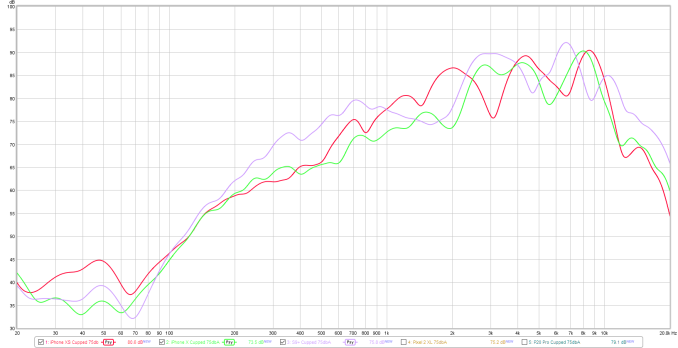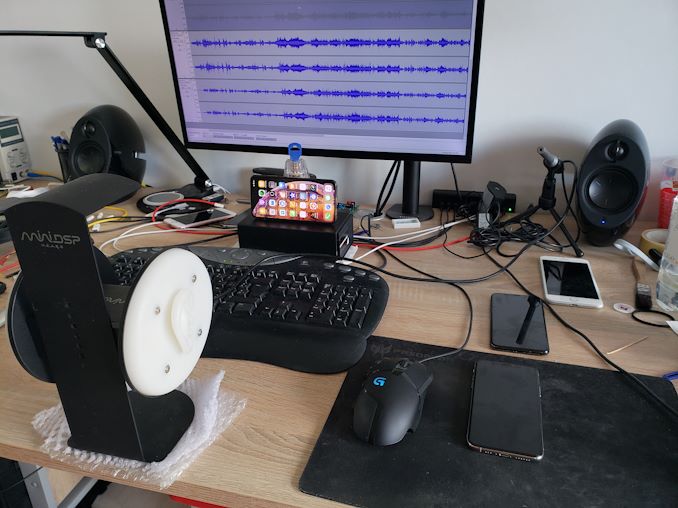The iPhone XS & XS Max Review: Unveiling the Silicon Secrets
by Andrei Frumusanu on October 5, 2018 8:00 AM EST- Posted in
- Mobile
- Apple
- Smartphones
- iPhone XS
- iPhone XS Max
Camera Video Recording
In terms of video recording, the iPhone XS promises an improved dynamic range in modes up to 30fps. What this likely means is that the phone’s able to capture in HDR mode in the 30fps modes, doing the same kind of processing we also see in SmartHDR still pictures.
Also something I’ve dreaded on iPhones for years; the new iPhone XS finally introduces stereo audio recording. Why it took Apple such a long time to finally introduce stereo recording is something that boggles the mind, but, let’s not complain, as we now finally have it on the new generation.
iPhone XS: iPhone X:
Comparing the iPhone XS video to the iPhone X, there’s one thing that is immediately very evident: the new XS is able to produce much better image stabilisation than last year’s flagship. Indeed, it looks like Apple vastly improved the OIS/EIS on the new phones, as the wobble that happens when walking is gone on the XS.
Audio recording finally is up to par, and we can hear the wind and rustling leaves of the trees around us. I think Apple might still have to work a bit on the wind noise cancellation, as in some parts the audio sounded as if it was inside a tube.
In terms of image quality, Apple’s claims of the improved dynamic range are very much verified. The phone showcases a lot more brought down highlights in the scene, and in darker areas, show better shadows. It’s unfortunate that this is limited only to the 30fps modes, but it’s understandable.
Switching over from the main lens to the telephoto lens happens relatively fast, although with a short exposure flash and a slight delay on the first zoom. 4K60 recording doesn’t allow for the use of the telephoto lens.
All in all, the video recording quality of the new iPhone XS is massively improved in all areas of stabilisation, picture quality, and audio. 4K30 recording on the XS is probably the best I’ve seen on any smartphone – a definitive applause to Apple for the improvements here.
Speaker Evaluation
Apple claimed to have improved the speaker audio quality on the new iPhone XS, allowing for more stereo separation and filling sound. I had introduced a new speaker evaluation method a few months ago because this year’s efforts by smartphone vendors to improve speaker quality has been very pronounced, and I wanted to have a way to objectively convey these improvements.
Starting off with speaker loudness, we’re measuring the phones at maximum volume, both in one-hand portrait mode, as well as two-handed mode where the palms are cupped towards the user. These two use-cases are what I find myself most often using the phone’s speakers in, so hopefully that also represents how most users use it as well, please let me know otherwise!

Using a pink noise signal, the iPhone XS pretty much falls into line with the results of the iPhone X, coming in at a very loud 82.8dBA in portrait mode and 87.6dbA in two-handed mode. Apple’s sound directionality on the iPhone X and XS is among the best, most likely due to the fact that the stereo earpiece is among the loudest of current generation smartphones.
Measuring the frequency response of the speakers, we see the iPhone XS closely following the measurement of the iPhone X, however there’s a major difference in the mid-range where the XS is around 5dB louder, raising instrumental frequencies and voices. This difference is what I think Apple is referring to when talking about better “fullness”, as it is evident when playing back media.
To better demonstrate the difference between the phones, I’ve attempted to capture them with a binaural microphone setup. Now I know my environment isn’t perfect as I don’t have the necessary sound dampening equipment, but I hope it does serve as an overall adequate A/B comparison between the phones. I’ve tried to calibrate the sound as much as possible recorded by the setup to a flat frequency response, although I’m sure there are improvements to be made. As a comparison, I also included calibrated speakers as a baseline to get an idea of the microphone setup.
The audio is meant to be listened to with headphones, or even better with IEMs, as this will give the intended playback of the binaural recording.
The iPhone XS’ improvements in the mid-range are quite evident as voices sound deeper and more pronounced on the new phone. Stereo separation is also quite good – resulting in a filling audio experience.
I included the S9+ and G7 as comparison devices. Samsung still does a significantly better job at the low-mid ranges which gives the phone more overall presence than the iPhones, also has an advantage in the very high frequencies giving more clarity, however the new iPhone’s XS strength point in the mid-ranges is the S9’s weakness, and vocals sound a lot less present than on the XS.
As for the G7, I just wanted to showcase a mono speaker device, and just how huge the audio difference is. Unfortunately the G7, even though it promises to have a good speaker, fails in practice.












253 Comments
View All Comments
Glindon-P - Friday, October 5, 2018 - link
Wider color range only works at 30fps because the camera actually records 2 frames at different exposures (at 60fps) and combines them.As far as higher FPS slow mo I’m sure it boils down to taking in enough light at high frame rates to be usable enough or just not something enough users care about. Anecdotally I’ve only used it just to test it and never again.
varase - Tuesday, October 23, 2018 - link
480 or 960fps slow mo is basically a gimmicky misnomer - how long can they sustain that frame rate before all the buffers fill up?How many takes does it require to actually capture the action you're trying to film within the window that that high frame rate actually operates?
Star_Hunter - Friday, October 5, 2018 - link
In past iPhone reviews NAND performance was looked at, I assume since it wasn't included this year that it remains the same?Andrei Frumusanu - Friday, October 5, 2018 - link
NAND is something on the to-do list in terms of revamping the test methodology - currently it's a mess both on iOS and Android.whiskeysips - Friday, October 5, 2018 - link
Can Anandtech take an photo of how the iPhone XS reproduces the following image on their review model?https://i.postimg.cc/q7wty6zY/Image-1.jpg
I have (5) iPhone XS has very poor color production on the following image, especially compared to my older iPhone7, see the example below:
https://i.postimg.cc/fbgFNbb1/226_E617_D-_A701-43_...
All of my iPhones also have a white point that appears significantly lower than 6500k judging by my eye. I do not have a colorimeter, but they do seem significantly off with certain content.
Unless the review models are cherry picked, I do not see retail units reaching the same quality.
Andrei Frumusanu - Friday, October 5, 2018 - link
How exactly are you expecting to test colour accuracy of an image through a photo?As far as I'm aware, the phones aren't cherry-picked and they were sealed and the battery was uninitialised.
whiskeysips - Friday, October 5, 2018 - link
The reference image is a screen shot of the content to be displayed so source content should be preserved.The color differences in the camera photo do reflect what I see with my eyes to a significant degree.
That is, on my iPhone7 and all my monitors in the house, the screenshot appears deep red at the top with a greyish red on the listed content.
On all the iPhone XS's in household, the content appears light red at the top, with the listed content becoming a distinct shade of brown instead of a greyish red.
I appreciate reading my post. The displays on my models do not seem all that accurate to me.
PhilJohn - Friday, October 5, 2018 - link
Have you properly calibrated the other phones and monitors in your house with a colorimeter? You'd be surprised at the awful D.e on most monitors out of the box.When the displays were tested for colour accuracy they were marked very highly, so it could very well be that the XS is showing the CORRECT colours.
whiskeysips - Friday, October 5, 2018 - link
So you are saying that all my previous iPhones I have retired, my current macbook, my spouses iMac, all the TV's in the household, and my two (non-Apple) desktop are all incorrect?AMC's brand color is red. The XS screen shows something similar to dried blood or a brown-red.
Did the app designers also have incorrectly calibrated monitors? The XS calibration is the problem, not the other way around.
PhilJohn - Friday, October 5, 2018 - link
And you've got night shift and true tone off? It could just be you have a dodgy OLED panel, check it against the ones in a store and exchange it if so.But you'd be surprised how awful most consumer electronics are for colour calibration, people like "pop" and "vivid" even when it's totally oversaturated and nowhere near accurate.
The calibration charts in this article should point to the XS having exceedingly accurate colours.